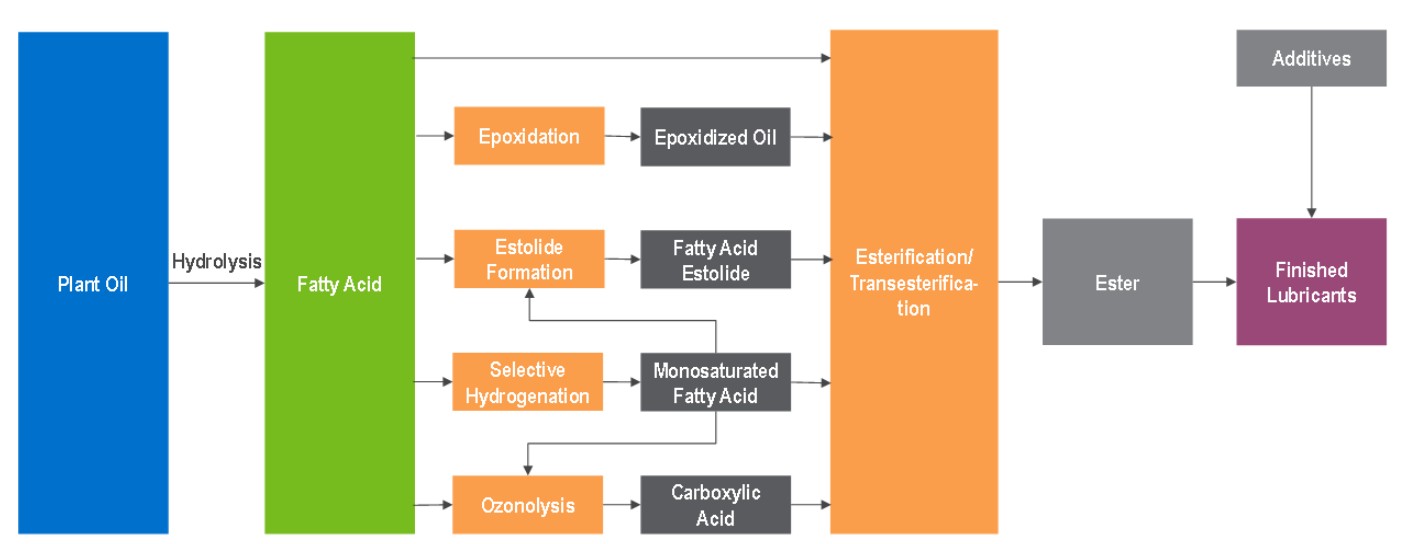Blogs
November 07, 2024From plant to machine: The promise of biolubricants in modern industry

Lubricants are an important component of modern industrial operations, ensuring the smooth functioning of machinery across diverse sectors such as automotive, manufacturing, engineering, and energy. By reducing friction, dissipating heat, and protecting against wear and corrosion, lubricants play an essential role in optimizing the performance and longevity of equipment.
As global regulations around vehicle emissions and fuel efficiency tighten, lubricant manufacturers are facing increased pressure to develop new products that meet these regulations while enhancing the performance and lifespan of machinery at the same time. The automotive industry is demanding lower viscosity oils which decrease engine friction and boost fuel efficiency, leading to lower carbon emissions. Engine oils that provide high performance and longer drain intervals are also gaining growing interest from original equipment manufacturers (OEMs) and consumers. In recent years, decarbonization trends in the transportation and industrial sector have seen the lubricants industry shift towards the development of more environmentally sustainable lubricants, and with it a rise in interest in biolubricants.
The Rise of Biolubricants
Biolubricants, derived from renewable sources such as plant oils and animal fats, are gaining traction as an environmentally friendly alternative to conventional, mineral-based lubricants. Their biodegradable and non-toxic properties, combined with a generally lower carbon footprint, make them a sustainable option especially in sectors where environmental protection is crucial, such as agriculture, forestry, marine, and mining. Biolubricants are also highly sought-after for applications in the healthcare and food-processing industries due to their non-toxic quality.
The push for biolubricants is largely driven by increasingly stringent environmental regulations and energy transition policies, particularly in developed regions such as North America and the EU. In the U.S., the Vessel General Permit (VGP) and USDA BioPreferred Program encourage the use of biolubricants in specific applications (e.g. marine). Voluntary labelling schemes like the European Ecolabel also reassure consumers and industries about the sustainability and performance of biolubricants, which in turn encourages the adoption of biolubricants to meet net zero goals.
Biolubricants can be classified into natural and synthetic oils. Natural oils - such as plant oils derived from rapeseed, soybean, sunflower, oil palm and castor beans - are inexpensive, exhibit higher biodegradability than mineral oils and have relatively simple processing steps. Plant oils are mainly composed of triacylglycerols - esters of glycerol with three straight fatty acid chains of various length (ranging from C12 – C24). Thanks to their high molecular weight and presence of a polar carboxyl group, plant oils generally have greater lubricity, higher viscosity indices and high flash points when compared to conventional mineral oils. However, plant oils have poorer cold flow behavior (demonstrated by their high pour points) and lower oxidative stability. They are also susceptible to hydrolysis, which can result in the corrosion of machinery parts.
Synthetic oils are formed when plant oils go through chemical modification routes such as esterification/transesterification, epoxidation and selective hydrogenation. These chemical modification steps are developed with the aim to improve the performance of natural oils for lubricant applications. Some synthetic oils are produced via consecutive chemical modification steps to obtain specific properties in the final biolubricant product. For example, epoxidized vegetable oils are further modified via esterification reactions or alkylation, acetylation or cooligomerization to improve low-temperature properties.
The major routes involved in the biolubricant production processes are shown in the schematic below:
Major Routes to Biolubricant Production
Today, companies like Novvi and Biosynthetic Technologies (BT) lead the innovation charge in the biolubricants space. Novvi’s SynNova® technology, for example, produces a sustainable synthetic base oil (SSBO) from farnesene, a renewable hydrocarbon derived from the fermentation of sugars. BT has developed estolides, a synthetic ester produced from natural seed oils that exhibits enhanced oxidative stability and viscosity, making it suitable for a wide range of industrial applications. Other companies such as Emery Oleochemicals and Cargill have also developed high-performance biolubricants using a combination of chemical modification routes including esterification, hydrogenation and ozonolysis.
Challenges in Adoption
Despite their advantages, biolubricants face several challenges in achieving widespread adoption. Production costs for biolubricants tend to be higher due to small-scale production and the reliance on specialized feedstocks and catalysts. They also face competition for feedstocks from other bio-based industries such as renewable fuels, chemicals and power, with both fuels and power generally benefiting from renewability credits which are not available to biolubricants.
Many renewable fuels and chemicals have overcome similar barriers through strong market demand and government support. However biolubricants have struggled to gain traction so far due to limited consumer awareness and the lack of comprehensive regulatory frameworks that support their adoption outside of North America and Western Europe.
Additionally, while biolubricants are generally perceived as environmentally friendly, some are yet to deliver comparable or superior performance to mineral-based lubricants in terms of viscosity, thermal stability and wear protection. Significant investment in R&D, as well as collaboration between lubricant manufacturers and OEMs are required to improve product yields and performance.
The Future of Biolubricants
As sustainability and product innovation emerge as central themes driving the lubricants industry today, biolubricants are poised to play a larger role in the global lubricants market within the next decade. However, achieving the right balance between performance, cost, and environmental impact will be crucial to their future success. For now, biolubricants appear to remain as a limited niche market, catering to specific applications within lubricants rather than being able to address the larger overall market.
Find out more...
Biorenewable Insights: Bio-Lubes (2024 Program)
This report covers a comprehensive analysis of biolubricants production technology, with primary focus on Novvi’s farnesene-derived base oil (FDBO) and Biosynthetic Technologies’ estolide processes.
This report also provides estimates of biolubricants production costs across United States Gulf Coast, Brazil, China, and Western Europe, incorporating Q2 2024 pricing data. A comparative analysis of the overall carbon intensity of biolubricants, considering scope 1 and scope 2 emissions is included.
The Authors...
Chong Jia Lin, Senior Consultant
Julian Mok, Analyst
About Us - NexantECA, the Energy and Chemicals Advisory company is the leading advisor to the energy, refining, and chemical industries. Our clientele ranges from major oil and chemical companies, governments, investors, and financial institutions to regulators, development agencies, and law firms. Using a combination of business and technical expertise, with deep and broad understanding of markets, technologies and economics, NexantECA provides solutions that our clients have relied upon for over 50 years.




